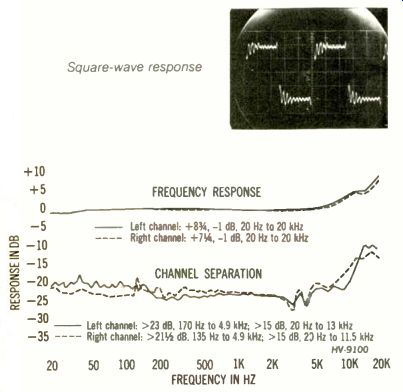Nagatron HV-9100--A Singular Transducer
Nagatron NV-9100 moving-ribbon stereo phono cartridge with elliptical stylus. Price: $220; optional HA-9000 head-amp, $275. Warranty: "limited," one year parts and labor.
Manufacturer: Nagatronics Corp., Japan; U.S. distributor: Nagatronics Corp., 2280 Grand Ave., Baldwin, N.Y. 11510.

The mystique surrounding the variations in methods of transduction in phono cartridges notwithstanding [see "The Anatomy of Magnetic Pickups," ], the results are electrically equivalent, differing principally in details such as output level and impedance. In the Nagatron HV-9100, the moving-coil arrangement is reduced to virtually its ultimate simplicity: A ribbon conductor (in effect a coil with a single turn) is coupled mechanically to the cantilever and made to move in relation to unusually powerful samarium cobalt magnets. One advantage claimed for this technique is that it contributes to reducing phase shift at high frequencies since inductance remains very low. An additional, perhaps more palpable advantage is that the cartridge is less sensitive to its load than even a normal moving-coil type.
------------------
Nagatron Model HV-9100 Phono Pickup
Sensitivity (at 1 kHz) 14.3 mV per cm/sec
Channel balance (at 1 kHz) ± <1/2 dB
Vertical tracking angle 14°
Low-frequency resonance (in SME 3009 arm) vertical 8 Hz; 2 dB rise lateral 7.2 Hz; 1 1/4 dB rise
Maximum tracking level (re RIAA 0 VU; 1.3 grams VTF) 300 Hz + 12 dB 1 kHz +15 dB
Weight (including shell) 19.3 grams
Tip dimensions tip radii scanning radius 23 by 6.6 micrometers 13 micrometers

--------- Square-wave response
--------- FREQUENCY RESPONSE
Conveniently, the Nagatron comes mounted in a headshell designed to fit standard Japanese tubular tonearms. Someone who tries to install the pickup critically will be chagrined to find that the nonadjustable overhang is excessive by roughly 1.5 to 2 millimeters. This positioning is, in fact, intentional and is said to be necessitated by the basic geometry of the cartridge. The company recommends that no attempt be made via other adjustments of the tone arm (if these are possible) to change the overhang back to a standard value.
While the Nagatron and its integral headshell constitute a rather massive package-sufficiently so to require that extra weight be added to the counterweight system on some tonearms--the internal damping and dynamic compliance of the cantilever suspension are such that the arm/cartridge resonance for vertical motion is fairly well placed in frequency considering the very low rise in amplitude response. The lateral resonance is less favorably placed, but it is yet more heavily damped than the vertical and has little effect on performance in any case. Being heavy enough to dominate the effective moving mass of most arm/cartridge systems, the cartridge can be expected to act much the same way in any tonearm.
Other lab data for the Nagatron reveal a normal complement of harmonic distortion, very low intermodulation distortion, and good maximum tracking levels. The frequency response, measured through the Nagatron HA-9000 head amp (as were the other data), shows a slight rolloff at low frequencies that can be attributed to the infrasonic filter incorporated in the head amp. Both channels show some excess gain from about 5 kHz upward, peaking somewhere above 20 kHz. The square-wave trace, with ultrasonic ringing evident, is consistent with the frequency-response data and reveals extremely fast rise and fall times, although with considerable overshoot. Separation is about average but consistent throughout the midrange.
In its sonic performance, as heard through our own head amp (another brand), the Nagatron is exquisite. The extra brightness implied by the rising high end of the frequency response curve is barely audible. Instruments such as brasses and percussion, characterized by sharp initial transients, are rendered with great finesse: The sound begins extremely quickly but without the edginess and harsh coloration sometimes produced by pickups whose reputations are based on transient handling. An excellent balance between fluid, effortless sound and precision of articulation seems to be the hallmark of this cartridge. As the data on low-frequency resonance suggest, the HV-9100 tracks warps with impunity and retains its composure even when subjected to moderately heavy shocks.
Though the differences in sound among fine phono cartridges are considerably greater, in general, than those among fine power amps, they are still quite subtle, and for a fairly substantial difference in cost, the Nagatron sounds only slightly different from more standard top-of-the-line pickups.
But the nicety of this difference does not nullify its importance. Considering the limited numbers in which the HV-9100 can apparently be made, we expect that eager audiophiles will keep dealer stockpiles small indeed.
----
(High Fidelity, Jan. 1979)
Also see:
SAE Model 2900 stereo preamplifier (review, Jan. 1979)
JVC turntables (ad, Nov. 1977)
Sansui DC amplifier (ad, Jan. 1979)